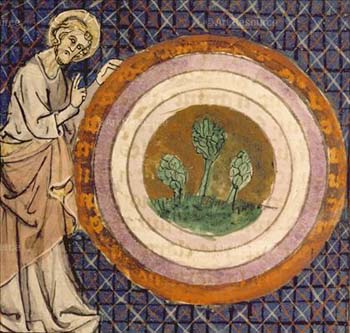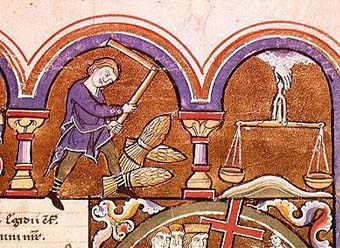 |
Symbolism
The Middle Ages, a Forest Filled with Symbols
Hugh O’Reilly
One needs to understand how the Middle Ages considered nature and the world. The universe was an immense book written by the hand of God in which every creature is a word charged with meaning.
The ignorant sees the forms understanding nothing further of their meaning. But the wise pass from the visible to the invisible, and in reading nature read the thoughts of God. True knowledge, then consists not in the study of things in themselves – the outward forms – but in penetrating to the inner meaning intended by God for our instruction.

God creates the world, giving every object a rich symbolism |
All being holds in its depths the reflection of Christ’s sacrifice, the image of the Church and of the virtues and vices. The material and the spiritual worlds are one.
The rose, symbol of Martyrs and Virgins
How mystical were the thoughts that arose in the minds of the medieval doctors in the presence of nature. Piero de Mora, Cardinal and Bishop of Capua, contemplates the roses in his garden. He does not consider just their natural beauty, but develops another type of consideration: “The rose,” he says, “is the legion of martyrs, or yet the choir of virgins. When red, it is the blood of those who died for the Faith, and when white, it is virginal purity. It opens among thorns, as the martyr grows up in the midst of heretics and persecutors or as the pure virgin blooms radiant in the midst of iniquity.”
The Church symbolized by a dove
Looking at a dove, Hugh of Saint Victor thinks of the Holy Church. “The dove,” he says, “has two wings, even as for the Catholic there are two ways of life, the active and the contemplative. The blue feathers of the wings are thoughts of heaven. The uncertain shades of the body, the changing colors of the neck that recall an unquiet sea, symbolize the ocean of human passions in which the Church navigates.
“Why are the eyes of the dove this beautiful golden color? Because yellow, the color of ripe fruit, is the color also of experience and maturity. And the yellow eyes of the dove signify the fullness of wisdom which the Church casts on the future.
“Finally, the dove has red feet, for the Church moves through the world with her feet immersed in the blood of the Martyrs.”
Precious stones, other symbols
Marbodus, Bishop of Rennes, contemplates precious stones and discovers a mystic consonance between their colors and things of the human spirit.
The beryl shines like sunlit water, and warms the hand that holds it. Isn’t this an image of the Catholic life illuminated and warmed to its depth by the sun, which is Jesus Christ?
The red ruby sending out sparks of fire is the image of the martyrs who, as they shed their blood, send up ardent prayers for their persecutors.
Light and darkness
Everything in the world is a symbol. The sun, the stars, the seasons, the day and night, all speak to us in a solemn language. In the winter, when the days sadly shorten and the darkness seems to be triumphing forever over the light, what is the medieval man thinking of? He considers the long centuries of twilight that preceded the coming of Jesus Christ, understanding that in the divine drama both light and darkness have their place. The medieval man gave the name of Advent (Adventus) to those weeks of December, when the liturgical ceremonies express the long waiting of the ancient world for the coming of the Savior. It was at the winter solstice, at the time when light begins to reappear and the days to lengthen, that the Son of Man was born.
The seasons of the year

The Autumn harvest reminds man of the Last Judgement |
The entire year is the image of the life of man on earth. Spring, which gives new life to the world, is the symbol of baptism, which renews the soul of man at his entrance into life.
Summer with its burning heat and resplendent light are reminders of the light of another world and the ardent love of God and the eternal life.
Autumn, the season of harvest and vintage, is the dread symbol of the last Judgment, that great day on which we will reap what we have sown.
Finally, Winter is the shadow of the death that awaits the resurrection of mankind and the renewal of the earth.
This is how the medieval man walked in a forest filled with symbols under a sky teeming with ideas.

Emile Male,
L’Art religieux du XIIIeme siècle en France, pp. 78-81

Related Topics of Interest
 The four beasts of the Gospel The four beasts of the Gospel
 Requiescant in pace... Burial customs Requiescant in pace... Burial customs
 The symbol of the sword The symbol of the sword
 Refuting anti-Catholic lies about the Middle Ages Refuting anti-Catholic lies about the Middle Ages
 Gargoyles and original sin Gargoyles and original sin
 Vice and vice symbolized in animals Vice and vice symbolized in animals
 Votive light, fire and candles Votive light, fire and candles

|
Symbolism | Religious | Home | Books | CDs | Search | Contact Us | Donate

© 2002- Tradition in Action, Inc. All Rights Reserved
|
 |
|